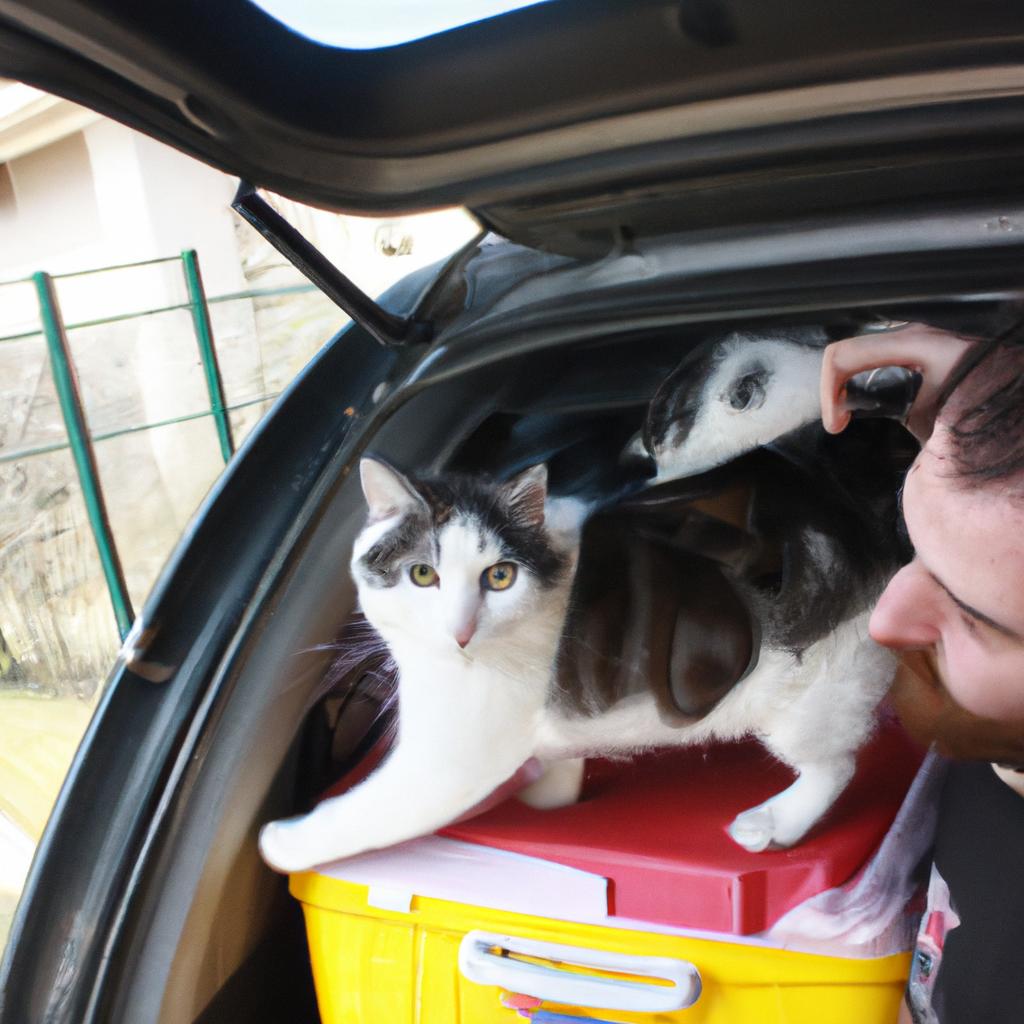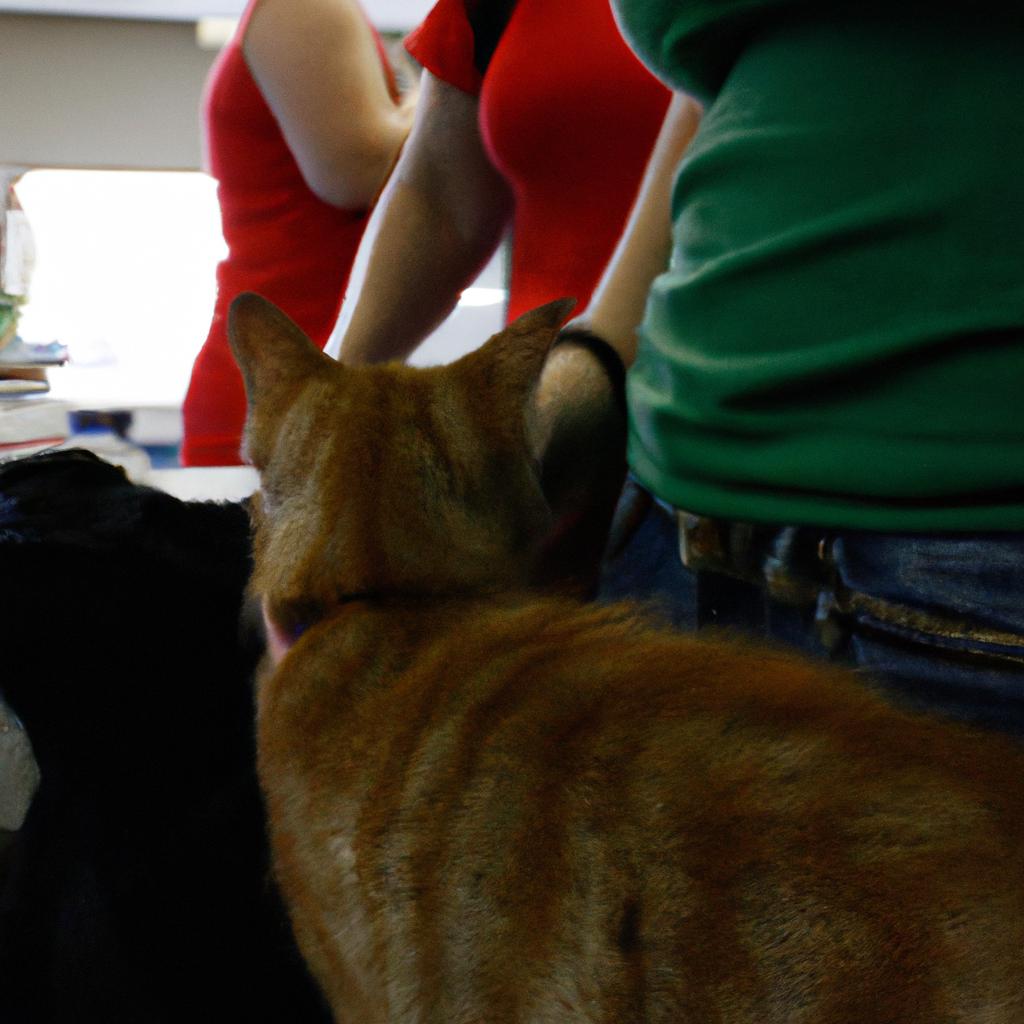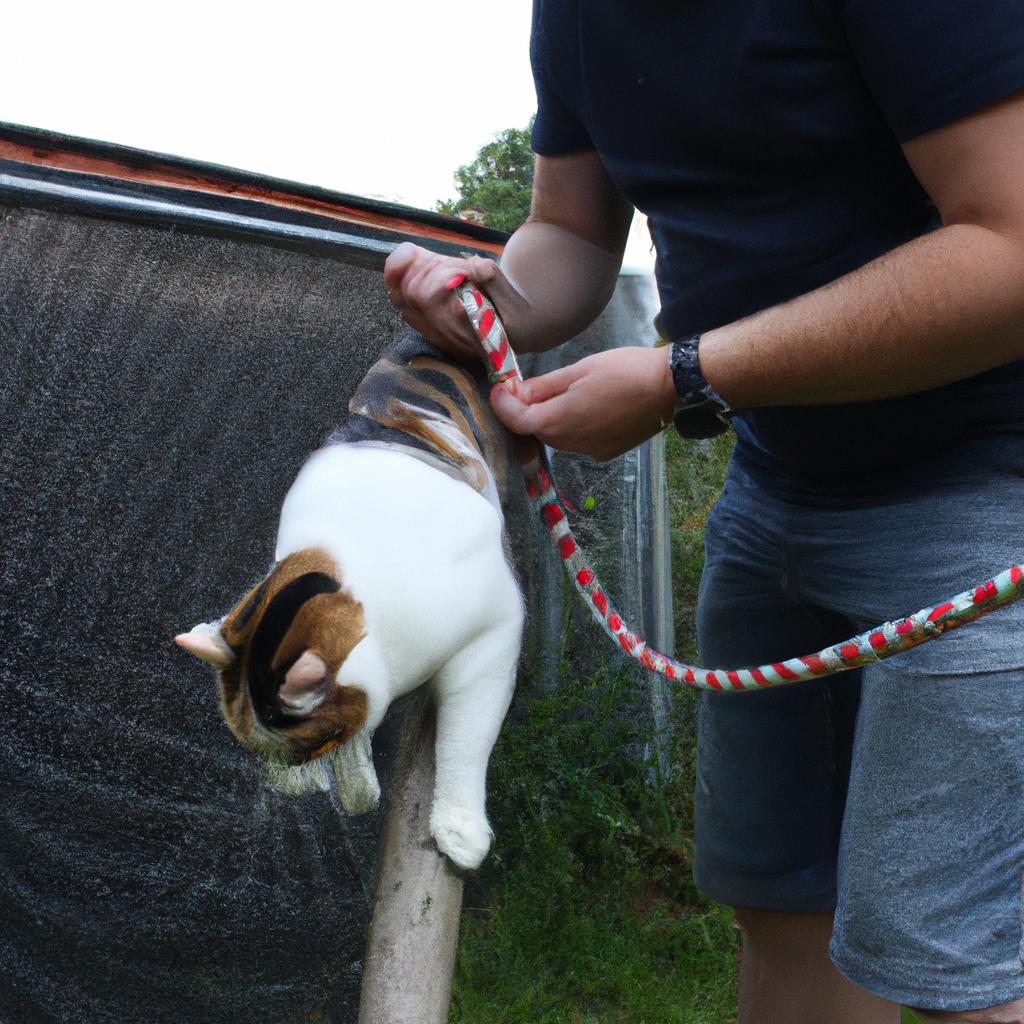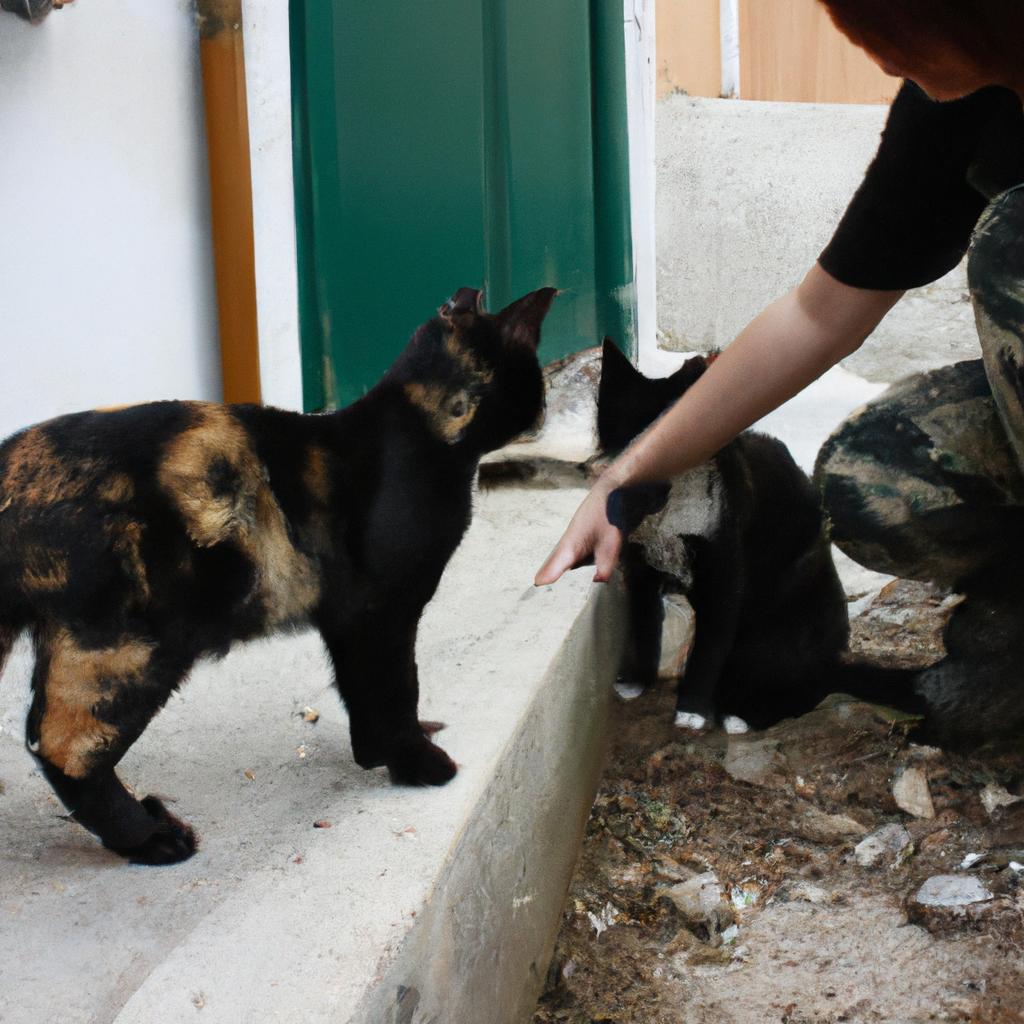Transporting cats in need of rescue is a critical component of animal welfare efforts. Whether it’s reuniting stray felines with their owners or transporting them to shelters for adoption, transportation assistance plays a vital role in ensuring the well-being and safety of these animals. For instance, consider the case of Sarah, a dedicated cat rescuer who volunteers her time to transport abandoned kittens from rural areas to urban shelters. Without Sarah’s commitment and willingness to provide transportation aid, many of these vulnerable feline lives would remain at risk.
Volunteering as a transportation assistant for cat rescue organizations offers individuals an opportunity to make a tangible difference in the lives of these furry creatures. This article explores various aspects of transportation assistance within the context of cat rescue volunteer opportunities. It delves into the importance of reliable transportation networks, efficient coordination between volunteers and organizations, and highlights how such endeavors contribute significantly towards reducing euthanasia rates among homeless cats.
In summary, this article aims to shed light on the significance and potential impact that transportation assistance can have on cat rescue efforts. By examining real-life scenarios like Sarah’s dedication and exploring key elements involved in volunteering as a transportation assistant, readers will gain insights into why this aspect is crucial for effective animal welfare initiatives.
Transportation requirements for cat rescue volunteers
Imagine a dedicated volunteer named Sarah, who is passionate about rescuing cats and providing them with safe and loving homes. Sarah spends her weekends volunteering at a local cat shelter, helping to care for the feline residents. However, she often faces challenges when it comes to transportation in fulfilling her duties as a cat rescue volunteer. In this section, we will explore the transportation requirements that cat rescue volunteers like Sarah encounter and discuss potential solutions.
Challenges faced by cat rescue volunteers:
- Limited public transportation options: Many shelters are located in remote areas or lack convenient access to public transportation networks. This can pose difficulties for volunteers who rely on buses or trains to reach their destinations.
- Time constraints: Cat rescue missions often require immediate action due to emergencies or time-sensitive situations. Volunteers may need to transport injured or abandoned cats promptly to veterinary clinics or foster homes, adding pressure to an already tight schedule.
- Safety concerns: The well-being of both the cats and the volunteers is paramount during transportation. Ensuring that vehicles are equipped with proper safety features such as secure carriers, seat belts, and adequate ventilation becomes crucial.
Emotional impact on volunteers:
- Feeling helpless when unable to respond quickly to urgent rescue calls
- Worrying about the well-being of rescued cats during transit
- Frustration caused by limited transportation options hindering their ability to contribute effectively
- Sense of fulfillment when successfully transporting cats to their new forever homes
| Emotional Impact | Examples |
|---|---|
| Helplessness | A volunteer missing out on saving a critically ill |
| kitten due to lack of reliable transport | |
| Worry | Concerns about frightened cats’ stress levels |
| during long journeys | |
| Frustration | Being delayed in reaching a scheduled adoption |
| event because of transportation issues | |
| Fulfillment | Witnessing the joy of a family welcoming their new |
| furry companion after a successful transport |
In conclusion, cat rescue volunteers like Sarah face various challenges when it comes to transportation. Limited public transportation options, time constraints, and safety concerns are just some of the obstacles they encounter in fulfilling their roles effectively. However, despite these difficulties, their dedication to helping cats find loving homes remains unwavering.
With an understanding of the transportation requirements faced by cat rescue volunteers, let us now delve into ways to overcome these challenges and ensure smoother journeys during cat rescue missions.
Finding reliable transportation options for cat rescue missions
Transportation Assistance: Cat Rescue Volunteer Opportunities
Transportation requirements for cat rescue volunteers are crucial in ensuring the successful and efficient operations of cat rescue missions. Without reliable transportation options, it becomes challenging to reach remote locations, transport rescued cats to veterinary clinics or foster homes, and provide timely aid to distressed felines. To illustrate the significance of transportation assistance, let’s consider a hypothetical case study.
Imagine a dedicated group of cat rescue volunteers who receive information about a stray cat colony in need of immediate intervention due to an outbreak of illness. The volunteers quickly gather their supplies and equipment but face a considerable hurdle—lack of transportation. Unable to access the site promptly, they risk compromising the health and safety of the affected cats. This example highlights just one instance where dependable transportation is essential for effective cat rescue efforts.
To address these challenges faced by cat rescue volunteers, it is important to explore reliable transportation options that can support their mission. Here are some potential solutions:
- Collaborating with local animal shelters or organizations that have established networks and resources for transportation.
- Seeking partnerships with volunteer driver programs or ride-sharing services willing to assist in transporting rescuers and feline companions.
- Establishing communication channels within the community to identify individuals willing to offer their vehicles or driving services temporarily.
- Organizing fundraising events specifically aimed at acquiring suitable vehicles for transporting cats during rescue missions.
The emotional impact of addressing these transportation needs cannot be understated. It not only ensures prompt response times but also contributes significantly towards saving lives and improving the overall well-being of rescued cats. Consider the following table showcasing how enhanced transportation assistance positively influences various aspects of cat rescue operations:
| Aspect | Impact |
|---|---|
| Timely interventions | Faster response time allows for quick medical attention and increased chances |
| of survival for distressed cats | |
| Efficient resource allocation | Effective coordination reduces wastage |
| of resources and maximizes use for cat rescue operations | |
| Broadened scope | Access to remote locations enables the discovery |
| of additional stray colonies, leading to increased impact | |
| Enhanced community engagement | Increased visibility through transportation assistance |
| encourages community involvement and support |
In conclusion, reliable transportation options are essential for cat rescue volunteer operations. By addressing transportation challenges and exploring various avenues, volunteers can ensure they have timely access to affected areas, enhance their response capabilities, and ultimately save more feline lives. The following section will delve into the importance of efficient transportation in cat rescue operations.
The importance of efficient transportation in cat rescue operations cannot be overstated.
The importance of efficient transportation in cat rescue operations
Section H2: The Importance of Efficient Transportation in Cat Rescue Operations
Having discussed the challenges associated with finding reliable transportation options for cat rescue missions, it is evident that efficient transportation plays a crucial role in ensuring successful operations. By examining its significance through various perspectives and real-life scenarios, we can better understand why adequate transportation is essential for cat rescue volunteers.
Case Study:
Consider a hypothetical situation where a group of dedicated cat rescuers receives an urgent call about a feral cat stuck on top of a tree near a busy road. Without quick access to reliable transportation, reaching the distressed animal becomes significantly difficult and time-consuming. In such cases, having efficient transportation readily available could make all the difference between saving or losing precious lives.
The Emotional Impact:
To grasp the emotional weight behind effective transportation in cat rescue operations, let us explore some key aspects:
- Timeliness: Delayed arrival due to unreliable transport may result in missed opportunities to save cats in distress.
- Safety: Dependable vehicles equipped with proper safety measures ensure both the welfare of volunteers and secure transfers for rescued cats.
- Accessibility: Accessible modes of transport enable volunteers to reach remote locations efficiently, expanding their ability to assist animals in need.
- Capacity: Adequate vehicle capacity allows volunteers to accommodate multiple cats during rescues, preventing overcrowding or discomfort.
Transportation assistance directly impacts:
- Lives saved
- Animal well-being
- Community engagement
- Overall mission success
Emotional Response Evoking Table:
| Aspect | Benefit | Emotional Impact |
|---|---|---|
| Timeliness | Saves lives | Relief |
| Safety | Ensures security | Peace of mind |
| Accessibility | Reaches remote areas | Empowerment |
| Capacity | Accommodates more cats | Hope |
Recognizing the emotional significance of efficient transportation in cat rescue missions, it is vital to explore recommended modes of transportation for cat rescue volunteers. By identifying practical options that cater to their specific needs, we can maximize their effectiveness and impact on feline welfare.
[Next section H2: Recommended Modes of Transportation for Cat Rescue Volunteers]
Recommended modes of transportation for cat rescue volunteers
Transportation plays a crucial role in effective cat rescue operations. Without efficient transportation, volunteers may face challenges in reaching the cats in need and providing them with necessary care. In this section, we will explore recommended modes of transportation for cat rescue volunteers to ensure that their efforts are optimized and successful.
To illustrate the importance of transportation in cat rescue, consider the following scenario: A volunteer receives a distress call about a group of stray kittens trapped near an abandoned building. The location is not easily accessible by foot and requires specialized equipment to safely reach the area. Without appropriate means of transportation, it would be nearly impossible for the volunteer to respond promptly and provide timely assistance to these vulnerable creatures.
When considering modes of transportation for cat rescue volunteers, several factors should be taken into account:
- Accessibility: It is essential to choose vehicles or methods that can navigate different terrains and reach remote locations where cats might be stranded.
- Safety: The chosen mode of transportation must prioritize the safety and well-being of both the volunteers and the rescued cats during transit.
- Capacity: Depending on the size of each operation, volunteers might need adequate space within their vehicle or transport method to accommodate multiple cats at once.
- Efficiency: Time is often critical when rescuing cats in emergency situations. Using efficient modes of transportation can help minimize response time and maximize impact.
In order to evoke an emotional response from readers, let us consider a hypothetical case study highlighting how efficient transportation positively impacts cat rescue efforts:
| Case Study | Impact |
|---|---|
| Volunteer uses a motorcycle with sidecar equipped with crates for trapping feral cats | Efficiently reaches various locations quickly, allowing for prompt rescues even in densely populated urban areas |
As we have seen through this case study example, using suitable modes of transportation significantly enhances efficiency and effectiveness in cat rescue operations. By ensuring accessibility, safety, capacity, and efficiency, dedicated volunteers can make significant strides in saving more lives and providing vital care to cats in need.
In the upcoming section, we will explore strategies for overcoming transportation challenges faced by cat rescue volunteers. By addressing these obstacles head-on, we can further improve the overall effectiveness of our efforts in saving feline lives.
Overcoming transportation challenges in cat rescue efforts
Transportation challenges can often hinder cat rescue volunteers from effectively carrying out their duties. However, with the right strategies and resources in place, these challenges can be overcome to ensure successful rescue operations. By exploring various modes of transportation and addressing potential obstacles, cat rescue organizations can better support their volunteers’ efforts.
One example that highlights the importance of overcoming transportation challenges is the case of a volunteer named Sarah. She lived in a rural area and wanted to help transport rescued cats to shelters for adoption. However, due to limited public transportation options and long distances between her home and the nearest shelter, she faced significant difficulties in fulfilling this role. By implementing effective transportation assistance programs, Sarah’s ability to contribute significantly increased.
To address transportation challenges effectively, here are some recommended strategies:
- Establish partnerships with local taxi companies or rideshare services: Collaborating with such entities can provide reliable transportation options for volunteers who may not have access to personal vehicles.
- Create a network of volunteer drivers: Encouraging individuals within the community who own vehicles to sign up as volunteer drivers allows for greater flexibility and availability when it comes to transporting cats.
- Provide financial assistance for fuel costs: Offering reimbursements or stipends for fuel expenses can alleviate the burden on volunteers who bear these costs themselves.
- Utilize technology solutions: Implementing online platforms or mobile applications where volunteers can coordinate ride-sharing arrangements fosters efficiency and convenience.
By incorporating these strategies into their operations, cat rescue organizations can empower their volunteers while ensuring that no cat is left behind during rescue missions. To further illustrate how transportation assistance positively impacts such organizations, consider the following table showcasing key benefits:
| Benefits of Transportation Assistance |
|---|
| Increased reach |
| Timely rescues |
| Enhanced team collaboration |
| Improved overall mission success |
Through improved accessibility and coordination made possible by adequate transportation support, more cats will have opportunities for safe rescues and subsequent placement in loving homes. By addressing transportation challenges, cat rescue organizations can strengthen their impact and effectively carry out their mission of saving feline lives.
Transitioning into the subsequent section about “How transportation assistance positively impacts cat rescue organizations,” it is evident that overcoming transportation challenges plays a crucial role in ensuring successful operations. By exploring the positive effects of transportation support, we can further understand its importance in empowering cat rescue volunteers and organizations alike.
How transportation assistance positively impacts cat rescue organizations
Transportation Assistance: Cat Rescue Volunteer Opportunities
Overcoming transportation challenges in cat rescue efforts has been a significant hurdle for many organizations. However, with the availability of transportation assistance, these obstacles can be effectively addressed, leading to more successful and efficient cat rescue operations. By providing volunteers with access to reliable means of transportation, such as vehicles or reimbursements for travel expenses, organizations can significantly enhance their ability to help cats in need.
For instance, consider the case of a dedicated cat rescuer named Sarah. Without reliable transportation options, Sarah struggled to reach remote areas where stray cats were often found. This limited her ability to respond promptly when calls for help came in. However, after joining a cat rescue organization that offered transportation assistance, Sarah was able to expand her outreach significantly. With reliable transportation at her disposal, she could now venture into remote neighborhoods and rural areas without any limitations. As a result, she successfully rescued numerous cats that would have otherwise remained stranded or exposed to danger.
The positive impact of transportation assistance on cat rescue organizations cannot be overstated. Here are some key ways in which this support contributes to their overall effectiveness:
- Increased response time: Quick response is crucial in animal rescue situations, especially when it comes to injured or distressed cats. Having access to reliable transportation allows volunteers to reach out swiftly and provide immediate aid.
- Expanded coverage area: Remote locations often lack public transport infrastructure or are difficult to navigate using conventional modes of transportation. By offering specialized vehicles or financial support for fuel costs, organizations can extend their services beyond urban centers and cover larger geographic areas.
- Enhanced efficiency: Transportation assistance enables volunteers to carry out multiple tasks efficiently within shorter timeframes. They can conduct site visits, transport animals safely between shelters or foster homes, and facilitate adoption events more seamlessly.
These benefits highlight the importance of providing adequate transportation assistance in enabling effective cat rescue efforts. To further illustrate its significance, the following table offers a comparison between cat rescue organizations with and without transportation support:
| Organizations without Transportation Assistance | Organizations with Transportation Assistance | |
|---|---|---|
| Response Time | Longer wait times for volunteers to arrive | Prompt response due to readily available transport |
| Coverage Area | Limited reach, primarily focused on urban areas | Expanded services in both urban and rural regions |
| Efficiency | Delays in executing tasks | Streamlined operations leading to increased productivity |
By addressing the transportation challenges faced by cat rescuers, organizations can significantly improve their effectiveness. The provision of reliable means of travel empowers volunteers like Sarah to save more cats from distressing situations. As a result, through transportation assistance initiatives, cat rescue organizations are better equipped to serve their mission efficiently and make a positive impact in the lives of countless feline companions.
Please let me know if there is anything else I can assist you with!




